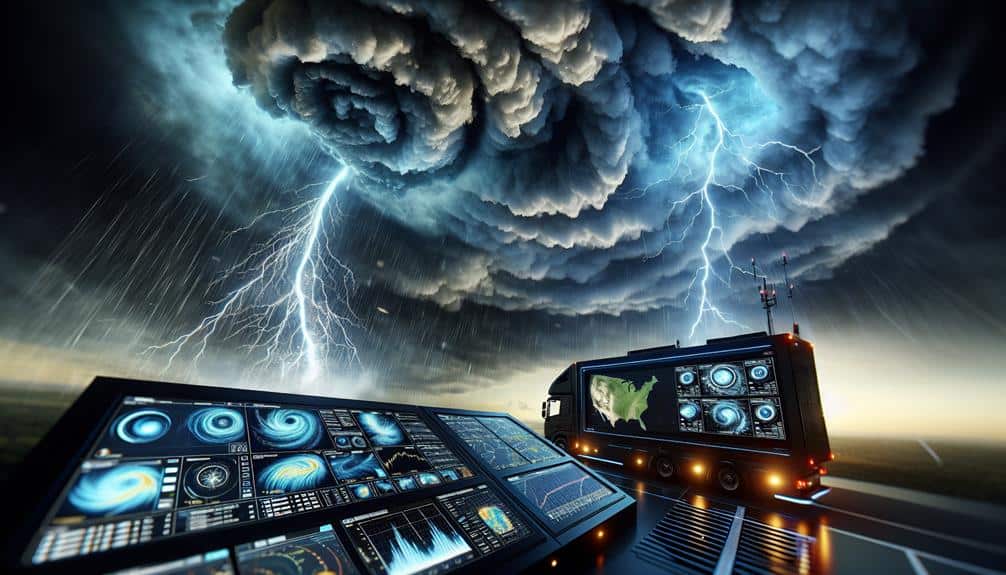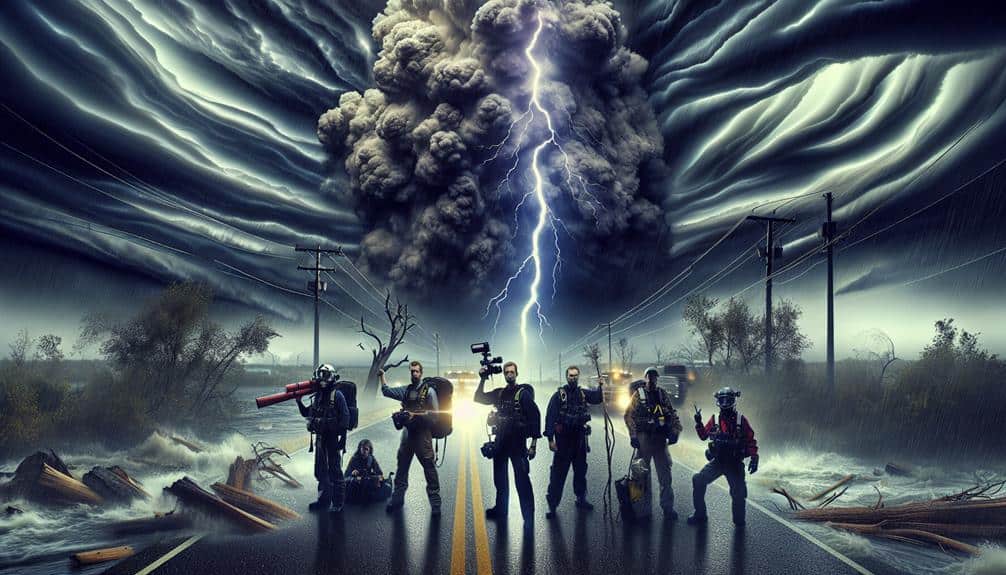As climate change escalates storm frequency and intensity, we must adjust our storm-chasing strategies with advanced tracking technologies like satellite systems, drones, and ground-based radars. These tools provide precise data on storm development and enable enhanced predictive modeling with machine learning algorithms. Upgraded safety protocols, real-time data analysis, and collaborative international efforts are crucial to managing risks. Community education and interdisciplinary studies further enrich our understanding and response capabilities. By developing these strategies and technologies, we guarantee that our methods remain effective in the face of evolving storm patterns. We'll uncover more about these advanced approaches.
Key Points
- Increased storm frequency and intensity due to climate change necessitates advanced tracking technologies for storm chasers.
- Enhanced predictive modeling using machine learning provides storm chasers with precise storm path simulations.
- Real-time data analysis enables storm chasers to make informed decisions and improve safety protocols.
- International collaboration and data-sharing networks offer comprehensive insights for storm chasing strategies.
Changing Storm Patterns
We've observed that climate change is directly altering storm patterns, resulting in increased frequency and intensity. As atmospheric temperatures rise, the amount of moisture that air can hold increases, leading to more intense precipitation events. This, in turn, amplifies storm severity, making them not only more frequent but also more destructive.
Our analysis of historical storm data confirms a significant upward trend in both the number and intensity of storms over recent decades. The correlation between rising global temperatures and increased storm severity is strong, supported by numerous peer-reviewed studies. As storm chasers, we need to pivot towards effective climate adaptation strategies to navigate these evolving risks.
Climate adaptation isn't just about surviving more violent storms; it's about anticipating them and minimizing their impact on our missions and communities. We must refine our predictive models and enhance our preparedness protocols.
Advanced Tracking Technologies
In adapting to climate change, we've integrated advanced tracking technologies that prioritize real-time data acquisition. This enables enhanced forecast accuracy, allowing us to anticipate storm behaviors with unprecedented precision.
Additionally, predictive modeling advances have revolutionized our ability to strategize and respond to emerging weather patterns.
Real-Time Data Acquisition
By leveraging cutting-edge satellite systems and drone technology, we can gather real-time meteorological data with exceptional accuracy. This revolution in weather monitoring allows us to adapt to changing climatic conditions more effectively. Technology advancements in this field enable us to deploy a multi-layered approach to data acquisition, giving us the freedom to make informed decisions based on precise, up-to-the-minute information.
To illustrate the capabilities of these advanced tracking technologies, consider the following:
- Satellite Systems: High-resolution satellites provide detailed global coverage, capturing images and data on storm patterns, precipitation, and atmospheric conditions.
- Drones: Equipped with sophisticated sensors, drones can fly into storm systems to measure variables like wind speed, temperature, and humidity, offering data that ground-based systems can't access.
- Ground-Based Radars: These systems complement aerial technologies by providing localized, real-time updates on storm development and movement.
- IoT Devices: Internet of Things (IoT) devices placed in strategic locations can continuously monitor environmental conditions, feeding data back to central systems for analysis.
Through these advancements, we're pushing the boundaries of what's possible in weather monitoring. This empowers us to respond more swiftly to severe weather events, mitigating risks and safeguarding communities.
Enhanced Forecast Accuracy
Leveraging advanced tracking technologies, we can achieve unparalleled forecast precision, allowing for more dependable predictions of severe weather patterns. Improved technology, such as Doppler radar advancements and satellite imaging, provides real-time data that enhances our capability to analyze atmospheric conditions. These tools, equipped with high-resolution capabilities, enable us to detect minute changes in storm development, leading to more precise alerts and timely evacuations.
Enhanced forecast precision isn't just a matter of better data; it's about transforming that data into actionable insights. By integrating machine learning algorithms with these advanced tracking systems, we can discern patterns that were previously undetectable. This integration allows for thorough risk assessments, enabling communities to prepare more effectively for impending storms. The application of such technology guarantees that resources are allocated efficiently, minimizing potential damage and loss of life.
The freedom to act swiftly in the face of severe weather hinges on our ability to predict it accurately. As we continue to develop and refine these technologies, our predictions will become even more dependable, giving us the confidence to take proactive measures.
In the ever-evolving landscape of climate change, improved technology remains our strongest ally in safeguarding lives and property.
Predictive Modeling Advances
Building on improved forecast accuracy, predictive modeling advances harness cutting-edge tracking technologies to simulate storm paths with unprecedented detail and reliability. We've seen remarkable strides in this field, particularly with the integration of machine learning algorithms. These advancements allow us to analyze vast datasets more efficiently and extract patterns that were previously undetectable. As a result, our ability to forecast storm behavior under various climate scenarios has greatly improved.
Machine learning doesn't just increase our predictive capabilities; it also enhances our climate adaptation strategies. By providing more accurate storm predictions, we can better prepare and mitigate the impacts of these extreme weather events.
Here are four key benefits of integrating machine learning into storm tracking:
- Improved Data Processing: Machine learning algorithms can process massive amounts of meteorological data in real-time, offering quicker and more reliable storm path predictions.
- Enhanced Accuracy: These algorithms continuously learn and adapt, refining their predictions based on new data, which leads to more precise storm forecasts.
- Resource Allocation: With better predictions, emergency services can allocate resources more effectively, enhancing public safety.
- Climate Adaptation Insights: Advanced predictive models provide critical insights into climate change's impact on storm patterns, aiding long-term adaptation planning.
Safety Protocols Evolution

Over the past decade, we've seen significant advancements in safety protocols for storm chasers, driven by both technological innovations and a deeper understanding of climate change's impacts. Central to these advancements is improved risk assessment, allowing us to predict potential dangers more accurately.
Enhanced radar systems, real-time data analysis, and machine learning algorithms are now integral to our decision-making process. These tools provide us with the precise information needed to assess the severity of storms and make informed choices about when to engage and when to retreat.
In addition to risk assessment, our emergency response strategies have also evolved. We've adopted advanced communication systems that guarantee constant contact with emergency services and other storm chasers. Satellite phones, encrypted radio frequencies, and GPS tracking enable quick coordination, reducing response times in critical situations.
We've also integrated automated alerts that trigger predefined safety protocols, such as evacuation routes and safe zones, ensuring a swift and organized response to sudden changes in storm behavior.
These safety protocol advancements not only protect our lives but also grant us the freedom to pursue our passion for storm chasing with greater confidence and security.
Collaborative Research Efforts
We must leverage interdisciplinary study approaches to enrich our understanding of storm patterns influenced by climate change.
Establishing robust data-sharing networks allows us to synthesize information across different research domains effectively.
Additionally, international collaboration initiatives are essential to standardize methodologies and broaden the scope of our findings.
Interdisciplinary Study Approaches
Interdisciplinary study approaches in storm chasing involve leveraging collaborative research efforts across meteorology, climatology, and environmental science to generate thorough insights on climate change impacts. By integrating these diverse fields, we can create a more holistic understanding of severe weather phenomena and their evolving patterns.
A key element of our approach is incorporating environmental psychology to understand how communities perceive and react to storm threats. This understanding helps us design more effective communication strategies and preparedness plans. Equally important is the use of geographic information systems (GIS) to analyze spatial data, track storm developments, and predict potential impacts with higher accuracy.
We focus on the following interdisciplinary strategies:
- Enhanced Data Collection: Utilizing advanced meteorological instruments and remote sensing technologies to gather detailed data on storm behaviors.
- Integrated Analysis: Combining climatological models with environmental science to assess long-term changes and their implications.
- Community Engagement: Applying findings from environmental psychology to educate and empower at-risk populations.
- Geospatial Mapping: Leveraging GIS to visualize storm paths, risk areas, and resource allocation efficiently.
Data Sharing Networks
Building on our interdisciplinary approaches, establishing robust data sharing networks is essential for enhancing collaborative research efforts in storm chasing and climate change studies.
By leveraging global partnerships, we can facilitate seamless information exchange, providing a thorough understanding of storm patterns and climate anomalies. Data sharing networks enable us to pool diverse datasets, ensuring that researchers worldwide have access to critical, real-time information.
Our technical approach involves creating interoperable platforms that integrate meteorological data from various sources, including satellite imagery, ground-based sensors, and storm chasers' field reports. This integration is crucial for accurate modeling and prediction.
Utilizing standardized data formats and protocols, we guarantee that the information is accessible and usable by different research teams, promoting transparency and replicability.
Evidence shows that collaborative networks greatly enhance predictive capabilities. For instance, during recent extreme weather events, shared data allowed for more accurate and timely forecasts, ultimately minimizing damage and saving lives.
International Collaboration Initiatives
Through international collaboration initiatives, storm chasers and climate scientists can pool their expertise and resources to greatly enhance our predictive models and mitigation strategies. By fostering global partnerships and research collaborations, we can achieve significant advancements in understanding and combating the impacts of climate change on severe weather events.
Key benefits of international collaboration include:
1. Shared Data Repositories:
By integrating data from diverse geographical locations, we can improve the accuracy and reliability of our predictive models. This allows us to anticipate storm patterns with greater precision.
2. Innovative Technology Development:
Collaborative efforts often lead to the creation of cutting-edge technologies that can enhance data collection and analysis. For example, jointly developed drones and satellite systems can provide real-time, high-resolution data on storm development.
3. Cross-disciplinary Expertise:
Partnering with scientists from various fields such as meteorology, oceanography, and atmospheric science enriches our research. This multidisciplinary approach fosters a holistic understanding and innovative solutions.
4. Resource Optimization:
Pooling resources allows for more efficient use of funding and infrastructure, ensuring that financial and material investments yield maximum returns in terms of research outputs and practical applications.
Real-Time Data Analysis

Leveraging advanced algorithms, we can process real-time weather data to enhance the accuracy of storm predictions. By integrating machine learning and predictive analytics, we can rapidly analyze vast datasets, identifying patterns and anomalies that traditional methods might miss. This real-time capability allows us to predict storm paths and intensities with unprecedented precision, ultimately providing communities with vital lead time to prepare and respond.
We utilize an array of data points—temperature, humidity, wind speed, and atmospheric pressure—collected from satellites, radar systems, and ground stations. These inputs are fed into sophisticated machine learning models that continuously refine their predictive capabilities. As these algorithms learn from historical data and real-time updates, their forecasts become increasingly dependable.
Our approach isn't just about crunching numbers; it's about empowering individuals and organizations with actionable insights. For instance, by accurately predicting a storm's trajectory, we can facilitate more effective evacuation plans and resource allocation, ensuring that those in harm's way can make informed decisions.
The freedom to act swiftly and decisively in the face of severe weather is a direct outcome of our commitment to real-time data analysis.
Community Education Initiatives
Community education initiatives play a pivotal role in enhancing public understanding of climate change and its impact on storm patterns. Through targeted outreach programs and the provision of educational resources, we can foster community engagement and increase climate awareness. Our analytical approach focuses on evidence-based methods to guarantee that the information disseminated is accurate and actionable.
We've identified several key components that make these initiatives effective:
- Outreach Programs: These are designed to reach a broad audience, using various platforms such as social media, community centers, and local events to disseminate information about storm patterns and climate change.
- Educational Resources: Providing accessible and scientifically accurate resources helps individuals understand complex climate data and its implications. These resources might include interactive websites, printed materials, and mobile apps.
- Community Engagement: Active participation from community members is vital. This can be achieved through workshops, town hall meetings, and volunteer opportunities that encourage locals to get involved and spread climate awareness.
- Feedback Mechanisms: Establishing channels for feedback guarantees that the programs remain relevant and can adapt to the needs of the community. Surveys, suggestion boxes, and focus groups are effective tools for this purpose.
Implementing these components helps empower communities, giving them the knowledge and tools necessary to adapt to changing storm patterns.
Frequently Asked Questions
How Has Storm Chasing Affected Local Wildlife and Ecosystems?
We've seen storm chasing impact local wildlife and ecosystems through habitat destruction and stress. This threatens biodiversity conservation efforts, as frequent disturbances can disrupt breeding and feeding patterns, ultimately altering species populations and ecosystem stability.
What Are the Psychological Impacts on Storm Chasers?
We experience significant mental health challenges and an emotional toll from storm chasing. The adrenaline rush and constant danger can lead to stress, anxiety, and PTSD, despite our passion for the freedom and excitement of the pursuit.
Are There Any Legal Restrictions on Storm Chasing Activities?
Sailing the stormy seas of storm chasing, we encounter regulatory limitations and ethical considerations. While legal restrictions are minimal, we must consider public safety and property rights. It's a delicate balance between freedom and responsibility.
How Do Storm Chasers Fund Their Expeditions?
We fund our expeditions through various funding sources, facing challenges along the way. Sponsorship opportunities and grants play pivotal roles, but securing them requires substantial effort and evidence-based proposals. Freedom in our pursuits drives our determination.
What Role Does Social Media Play in Modern Storm Chasing?
Social media enhances our public engagement and data collection by allowing real-time updates, crowdsourced information, and broader reach. It empowers us to share findings instantly, fostering community involvement and improving the accuracy of storm tracking.


